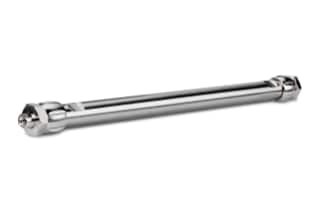
|
Chemistry |
C8 |
|
Separation Mode |
Reversed Phase |
|
Particle Substrate |
Hybrid |
|
pH Range Min |
1 pH |
|
pH Range Max |
12 pH |
|
Temperature Limits |
60 C (Low pH) / 60 C (High pH) |
|
Maximum Pressure |
6000 psi (415 Bar) |
|
Endcapped |
Yes |
|
Silanol Activity |
Low |
|
Particle Shape |
Spherical |
|
Particle Size |
5 µm |
|
Endfitting Type |
Waters |
|
Pore Size |
130 Å |
|
Format |
OBD Prep Column |
|
Surface Area |
185 |
|
System |
HPLC Preparative |
|
Particle Technology |
BEH |
|
Technique |
LC, LC/MS |
|
USP Classification |
L7 |
|
Inner Diameter |
10 mm |
|
Length |
250 mm |
|
Carbon Load |
13 % |
|
UNSPSC |
41115709 |
|
Brand |
XBridge |
|
Product Type |
Preparative Columns |
|
Units per Package |
1 pk |
XBridge BEH C8 OBD Prep Column, 130Å, 5 µm, 10 mm X 250 mm, 1/pk
When compared to the XBridge BEH C18 sorbent, the XBridge BEH C8 sorbent is less retentive. Anyone developing methods may prefer the faster speed provided by a less retentive column while improving peak shape and chromatographic performance. The tri-functionally bonded sorbent has the broadest usable pH range (1-12), superior low pH stability, and extremely low column bleed.
The use of chromatographically equivalent columns is required for the successful scaling of methods from analytical to preparative dimensions. Methods do not scale all too often, even when the same chemistry phase and particle size are used, due to loss of resolution and/or lower-than-expected loading. Scalability is ensured by matching the analytical and preparative column bed densities, eliminating the need for time-consuming method redevelopment.
The bed densities of OBD Preparative Columns closely match those of the equivalent analytical column. This novel method yields preparative columns with high stability, reproducibility, and efficiency. OBD Preparative Columns are designed to increase laboratory throughput when directly scaling methods from UPLC to OBD Preparative HPLC Columns and maximizing productivity when scaling up screening methods to preparative HPLC by screening with high resolution and speed from UPLC/UHPLC technology.
Waters offers a wide range of products to ensure that you can meet all of your laboratory requirements, as we understand that not every piece of equipment can be used for every type of analysis. You can shop for lab equipment by browsing our catalog or visiting our website. You can also reach out to one of our international customer service representatives via our website, who will assist you with any questions or concerns you may have and recommend the best equipment for your needs.
You may also be interested in XBridge BEH C8 Prep Guard Cartridge, 130Å, 5 µm, 10 mm X 10 mm, 1/pk; in comparison to the XBridge BEH C18 sorbent, the XBridge BEH C8 sorbent is less retentive. Anyone creating methods may prefer the speed provided by a less retentive column while improving peak shape and chromatographic performance. The tri-functionally bonded sorbent has the widest usable pH range (1-12), the best low pH stability, and the least amount of column bleed.
What Techniques Should Be Used To Isolate And Prepare Analytes?
Two common SPE techniques are used to isolate and prepare sample components of interest. The retention-cleanup-elution method is typically used when the concentrations of the target chemicals are too low for precise quantification. This method results in the concentration of diluted samples as well as trace chemical enrichment. A pass-through cleanup method may be used if the desired sample component is present in high concentration. There is no sample enrichment when using a pass-through cleanup approach.